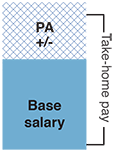First established in 1957, the post adjustment system helps to ensure that that no matter where United Nations common system staff work, their take-home pay has a purchasing power equivalent to that at the base of the system, New York. Post adjustment is an amount paid in addition to salary that accounts for the following elements: differences in prices between the location where the staff member works and New York; local inflation; the exchange rate of local currency relative to the United States Dollar; and the average expenditure pattern of staff members at a given location. Together, the net base salary and the post adjustment add up to the net remuneration, or take-home pay.
It is applicable to the United Nations Common System international staff in the Professional and higher categories.

The post adjustment is a variable component that is adjusted periodically to reflect changes in the cost of living in a duty station.
When the United Nations was established, inflation and exchange rates remained relatively stable. Thus, it was possible to apply a simple system of salary adjustment. Following the expansion of UN activities in the mid-1950s, the need arose for a more accurate and responsive system that could be easily and efficiently administered. Over the decades, the post adjustment system has been improved, resulting in greater transparency and active participation of staff in the process.
Under its statute, ICSC is mandated to manage the system and calculate post adjustment indices. The Advisory Committee on Post Adjustment Questions (ACPAQ) advises ICSC on technical aspects, including statistical methodology.
The calculation of post adjustment indices reflecting cost-of-living and currency movements at the different locations in the United Nations common system is one of the Commission's main responsibilities. To obtain the inputs for these calculations, the Cost-of-Living Division of the ICSC Secretariat organizes the periodic collection of data through cost-of-living surveys. Numerous surveys are conducted at duty stations each year, and much of the data used to compute post adjustment levels are collected from staff.
The Post Adjustment Index (PAI) for a given location is a measure of the cost of living of staff at that location relative to the base city, New York. The post adjustment multiplier (also known as the post adjustment classification) is usually equal to the post adjustment index. However, other rules may affect the determination of the multiplier.
The main components of the PAI are: